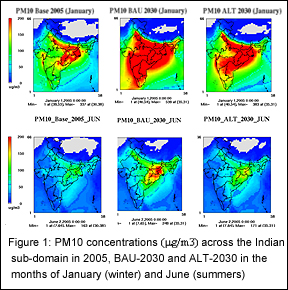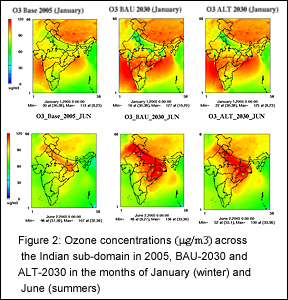The Ozone Crisis
For India the particulate matter pollution is not the only concern; secondary pollutants such as Ozone are the emerging threats for the fast developing nation. In the last two decades, India has shown tremendous economic growth and has correspondingly witnessed a rapid increase in energy consumption patterns.

While the population of India has grown three times during 1951-2006, industrial production has grown 28 times. The economic growth of the country has fueled the demand for mobility. Hence, vehicles have grown 328 times during the same phase, with most of them in the private (two-wheelers and cars) segment. This has led to the rise in greenhouse gas emissions and also air pollutants such as sulfur dioxide, nitrogen oxides, particulate matter, volatile organic compounds, and more.

Most of the Indian cities show violation of the National Ambient Air Quality Standards in terms of particulate matter concentrations. While introduction of advanced vehicular emission norms have attempted to arrest the growth of particulate matter emissions in India, nitrogen oxide emissions have not been controlled effectively.
Pollutants like nitrogen oJdd.es and non-methane volatile organic carbon (NMVOCs) react in the presence of sunlight to produce Ozone at ground levels which is not only injurious to human health, but could also damage the agricultural yields. As India is exposed to higher photo-chemical activity, it is bound to have a higher production rate of Ozone and the presence of significant emission sources helps in its formation. In India, while there is extensive monitoring of pollutants like sulfur dioxide, nitrogen oxides, and particulate matter, the Ozone is monitored in a very limited manner.
Toyota Motor Corporation (TMC), Japan, initiated a project in 2008 with a view to reduce energy consumption and improve air quality in East and South Asia. This was a multi-institutional study with partners from Japan (Toyota Motor Corporation and Toyota Central R&D Labs), China (Tsing-hua University), Austria (International Institute for Applied Systems Analysis), and India (The Energy and Resources Institute). The main objectives of the project were to assess the energy consumption, emissions and air quality in East and South Asia, to project future energy scenarios and predict air quality based on simulations for the year 2030, and to plan for the reduction of energy consumption/carbon dioxide emission and improvement of air quality.
As part of the study, India's The Energy and Resources Institute (TERI) assessed the energy and emissions scenarios for the year 2005 to 2030 for various states and union territories of India for different pollutants like particulate matter, oxides of sulfur, and nitrogen oxides. TERI also prepared an inventory of NMVOCs emissions for the country.
The energy mix of the country shows that biomass in the domestic sector and coal in the power generating sector are the dominating fuels. The overall inventories for India show that the industrial sector dominates the particulate matter emissions whereas the transport sector has a major share in nitrogen oxides while power plants contribute more to the sulfur dioxide emissions. Biomass burning has the maximum share in NMVOCs emissions.
The modeling results show prominent regional scale concentration of pollutants like particulate matter over the country, especially in the winter months. However, Ozone shows higher concentrations during summers due to higher photochemical activity. Urban centres show very high concentrations of nitrogen oxides due to rise in vehicular activities (lesser Ozone was observed in such cities due to titrating reaction of nitrogen oxides with Ozone).
Based on the baseline assessment, future scenarios were developed till the year 2030, considering the Current and alternate policies in different sectors (see "Regional Scale View Of The Problem"). Future predictions for these pollutants depict high concentrations in the business as usual scenario for 2030. These concentrations are likely to impact human health in many ways and there could be a substantial decline in the yield of various food crops due to the rise in Ozone-concentrations.
The alternate scenario takes into account aggressive renewable energy penetration, improved energy efficiencies in various sectors, and the move towards public transport, cleaner fuels and technologies. The scenario shows an improvement in the levels of air quality. However, there is still a lot of action required to bring air quality within the permissible limits.
The research is a step forward in the direction of evaluation of air quality with advanced tools which not only improve the accuracy of prediction, but are also able to present regional scale view of the problem.
While primary pollutants can be controlled through straightforward strategies, secondary pollutants like Ozone require understanding of different roles played by various precursors and meteorological conditions in formation.

